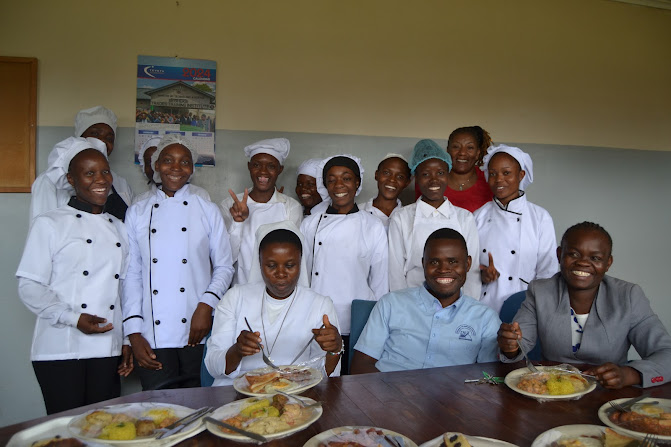By Derrick Silimina
When Monica Jiwani relocated to Arusha, the third-largest city in Tanzania, she was dreaming of a happy life in a scenic area. Instead, she was immediately confronted with a harsh and painful reality - scarcity of clean water.
The thought of using contaminated water became a constant source of headache.
Arusha is at the foot of the volcanic Mount Meru, and is a gateway to safari destinations and to Africa’s highest mountain, the 5,895-metre-high Mount Kilimanjaro, located 100 km away in the northeast.
As people flock to this city in the hope of a better life, they are shocked to find that there just isn’t enough clean water for everyone.
“Many people are getting sick here from water-borne diseases. We have young children in this community and I’m really worried about their safety,” Jiwani told ChinAfrica while walking with a baby strapped on her back and a bucket in hand in search of fresh water.
During times of water scarcity, Jiwani has to walk for about an hour from her place in the Njiro suburbs of Arusha to fetch water from a neighbouring place.
The 30-year-old mother of two revealed that due to the need to fetch water, many girls are forced to drop out of school and most women are left with fewer options to earn an income.
Disproportionate burden
In Sub-Saharan Africa, women and girls spend 200 million hours every day collecting water, a colossal waste of their valuable time, according to the United Nations Children’s Fund.
Attaining the United Nations’ Sustainable Development Goal for water and sanitation, which calls for universal and equitable access to safe and affordable drinking water by 2030, seems far-fetched on the continent.
“Having our own borehole is the best solution for my family. I am tired of hoping that one day we will have piped water,” said Cathy Ndagala, a resident of Arusha’s Arumeru District, adding that she knows the pain of water shortage as she is used to walking long distances to find safe water.
Ndagala, 35, stressed that fighting and quarrels at water points in her community are rampant as women, men and children battle for the scarce water.
“We even go for three days without having a shower due to lack of water here,” said Ndagala, who is among the majority of residents in the Arumeru who have to use the little water they get for cooking, and forgo other tasks like washing clothes.
A recent United Nations study of 24 countries in Sub-Saharan Africa showed that when water is not piped to the home, the burden of fetching it falls disproportionately on women and children, especially girls. In Guinea and Tanzania, women spend twice as much time as men on collecting water on average.
Timely help
However, the residents of many areas in Arusha no longer need to spend sleepless nights over the access to clean piped water for their household needs, thanks to a new water supply system project built by Chinese construction firm PowerChina International Group.
PowerChina recently signed the contract for the construction of the new Arusha water supply system project, which is owned by Arusha Urban Water Supply and Sanitation Authority (AUWSA).
PowerChina Project Manager Jin Denghui said that the project involves fetching groundwater at the foot of Mount Kilimanjaro and supplying it to the targeted households in Arusha every day. The project mainly consists of a major water pipeline of about 176 km, a water supply network of about 400 km, 10 reservoirs, five transfer lift pump stations, 43 deep well pumps and 29 water hammer tanks, among other facilities.
“I can now access clean and safe water just a stone’s throw away from my home,” said Jiwani, who is now one of the beneficiaries of the water project financed by the African Development Bank and the Africa Growing Together Fund.
The state-of-the-art water supply facility is indeed a game-changer for the local community in Arusha’s catchment area in terms of sanitation. In addition, the project has provided more than 4,000 jobs for the local people during the construction, organised professional training on welding, and trained a group of technical and management staff.
“The project has improved the living conditions of residents and has helped to expand the local economy through job creation,” Jin noted.
“Approximately more than 1 million citizens have benefitted from the project, including an average of 250,000 people who enter and leave the city every day, 143,770 citizens from Arumeru District, 9,049 citizens from Hai District in Kilimanjaro Region, and 6,529 citizens from Simanjiro District in Manyara Region,” AUWSA Director Justine Rujomba said.
Rujomba thanked the government of Tanzania for facilitating the implementation of this project, which has solved the water challenges in Arusha and some other areas.
The Tanzanian Ministry of Water formally conveyed its appreciation to PowerChina for the company’s significant contribution to completing the Arusha water project in a letter sent in January 2022.
Tausi Kida, permanent secretary in the President’s Office for Planning and Investment, disclosed recently that from January 2021 to December 2023, the Tanzania Investment Centre registered 256 Chinese projects worth about $2.5 billion, and the top five sectors for these projects were manufacturing, commercial building, agriculture, transportation and services.
The Tanzania Private Sector Foundation has since noted that the country is making significant strides in improving the investment climate, which has shown tangible results, including $11 billion in projects led by Chinese investors, creating more than 114,726 jobs.
Chinese Ambassador to Tanzania Chen Mingjian said China has emerged as a leading source of foreign direct investment in Tanzania, significantly contributing to the country’s development.
The Chinese envoy commended the Tanzanian government’s determination and proactive measures in attracting investment and promoting economic development.
“We are confident in Tanzania’s future development prospects,” she stated during the China-Tanzania Investment Forum and China-Tanzania Trade and Investment Promotion Conference held recently in Dar es Salaam.






.JPG)

